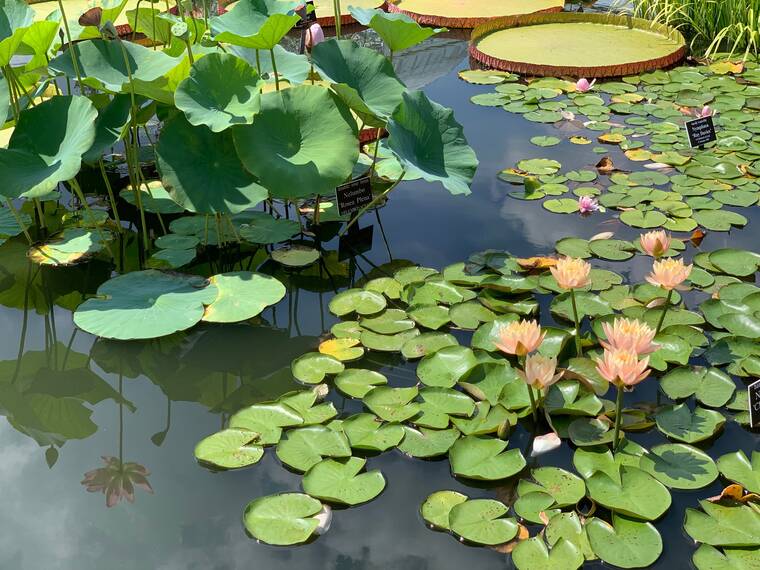Tropical Gardening: Create rock and water elements to cool garden enjoyment
Let’s admit it, the world is getting hotter and this affects our island gardens. Hawaiian landscapes certainly have enough lava rock but may be lacking in water elements like streams, ponds, lakes and ocean frontage. In many other parts of the world, rock and water elements are used in the landscape to create a natural feeling and add interest to the design. Balinese gardens usually include not only naturalistic forms, but often, sculptured elements as well. In Japan the stone water basins that stand outside the teahouses are an example of rock and water used on a small scale. In almost any garden, the gentle sound and sight of water running over cool stones is refreshing.
Here on the Volcano Island, we have fantastic rock formations with which to work, and we have sufficient water to create outstanding landscapes. Many of the newer developments in West Hawaii are using the rough and rugged lava fields as part of the basic design. Unfortunately, many lots being developed are quickly cleared with no thought to the natural lay of the land.
ADVERTISING
If you are considering incorporating rock and water elements into your landscape, there are several ways to expand your imagination. Of course you could take a trip to Bali or Japan, but a less expensive way would be to get together with other creative folks who have similar interests. Another way to get ideas is to check out the numerous books on the subject at local libraries and bookstores. Many private and public gardens utilize natural rock and water to create a peaceful effect. Visit these and places like our upscale hotels to get ideas. Of course, there are numerous landscape architects and landscape contractors who can assist you as well.
Before you start to work, here are some tips to help you avoid mistakes. A rock and water garden may be located in a sunny exposed area but shade is usually better. Sunny locations require plants that tolerate intense sun and even drought. Cool and shady locations allow for a greater selection of plant materials that fit a water garden setting. Of course if you live in an area where it rains for weeks at a time, you might want to select a sunny spot for your creation. There are always exceptions to the rule.
In selecting rock, avoid little piles. Use large boulder types where possible. Our native lava is beautiful, but may weigh several hundreds of pounds. It takes heavy equipment to move these types or lots of guys with muscles. Watch out for your back and maybe a lawsuit if someone gets hurt. You will probably be better off contacting a contractor who has the kind of equipment you need.
Placing rock takes a special talent, but if you are good at placing furniture just right, then you shouldn’t have too much trouble. Guys, if your wife is the one with the artistic eye and she has you moving the furniture back and fourth a dozen times before it is right, then watch out for her rock placing practices! Place the rocks so that there will be little nooks and crannies for planting as well as an interesting pattern for water flow.
Pool construction need not be difficult or expensive with the new material available. Obviously, you need a waterproof basin in which to hold the water. This can be constructed with concrete and wire mesh for a permanent pool or you may use a heavy polyethylene plastic for one that is less permanent. At the Kona Cloud Forest Sanctuary, we experimented with a small eight by fifteen foot pool using ten mil plastic four layers thick.
It is twenty years old and still holds water, fish and water plants with a minimum of care. The total cost of the pool was about fifty dollars.
To move water and create a cascade or flow, you will need a small circulating pump. A good one may be purchased for less than two hundred dollars.
Once you have your water garden in order, consider growing water lilies and other interesting water plants. You can’t beat water lilies for adding a flare of brilliant color to garden ponds. They may even be grown in big tubs, pots or urns filled with water.
Tropical water lilies surpass our more common types for their spectacular flower size. The colors range from shades of blue and purple to unusual orange tints. You can grow day blooming types combined with night bloomers for twenty four hour enjoyment.
Many other aquatics may be grown as well. Lotus, papyrus, water lettuce and water hyacinths all add to the enjoyment of a water garden.
To avoid mosquito problems, you should add mosquito eating fish, some bug eating lizards, and before you know it you have created your own little ecosystem to enjoy. For mosquito control, you may also use a product containing Bacillus thurengiensis var. israelensis. This will kill mosquito larvae without harming fish or other animals. Some products are available at our local garden shops containing this natural mosquito killer will last a month or more.


